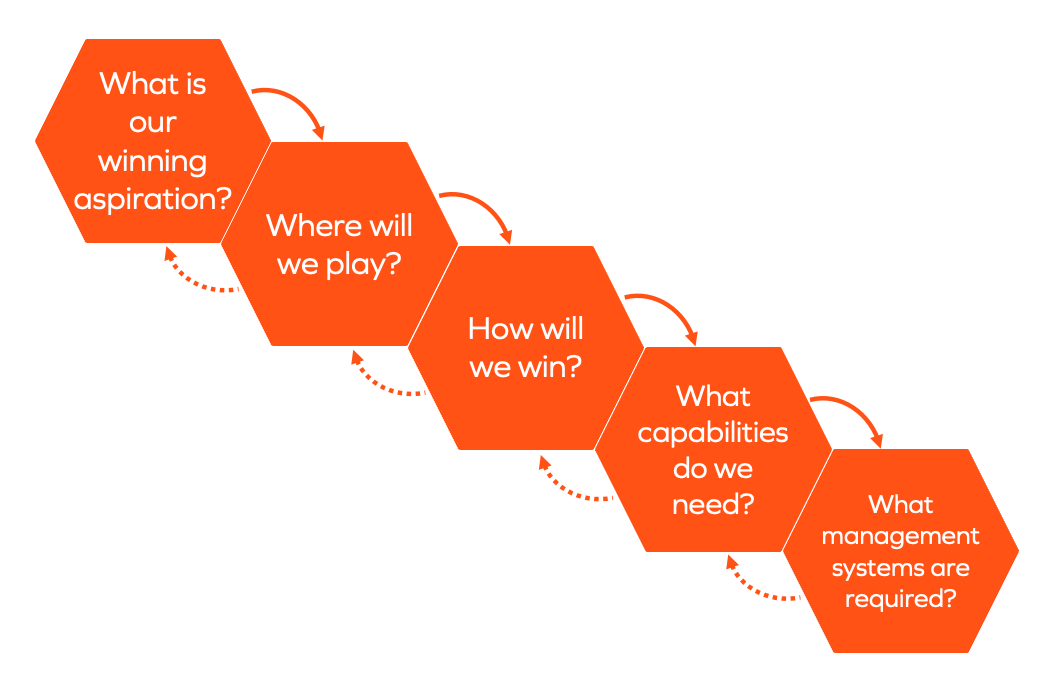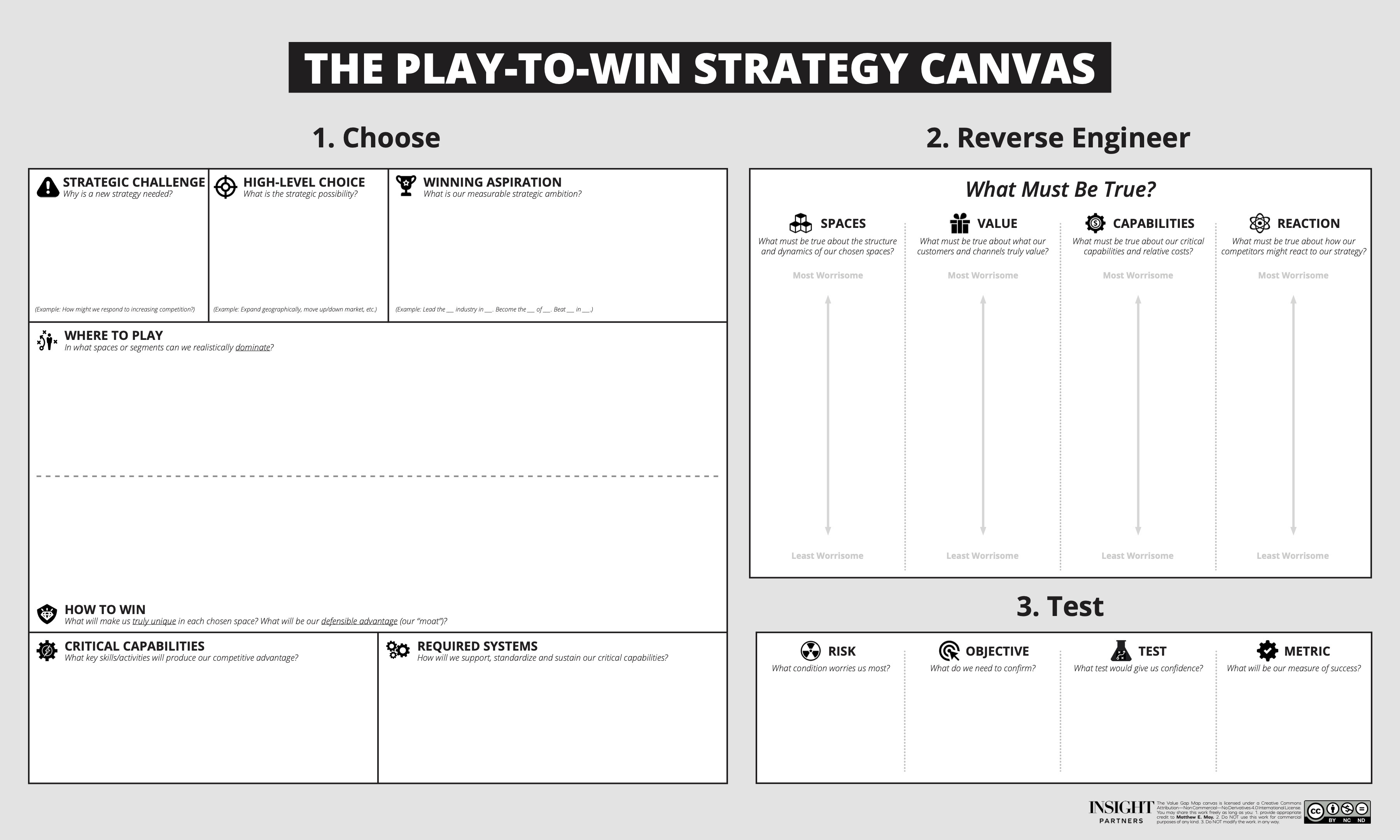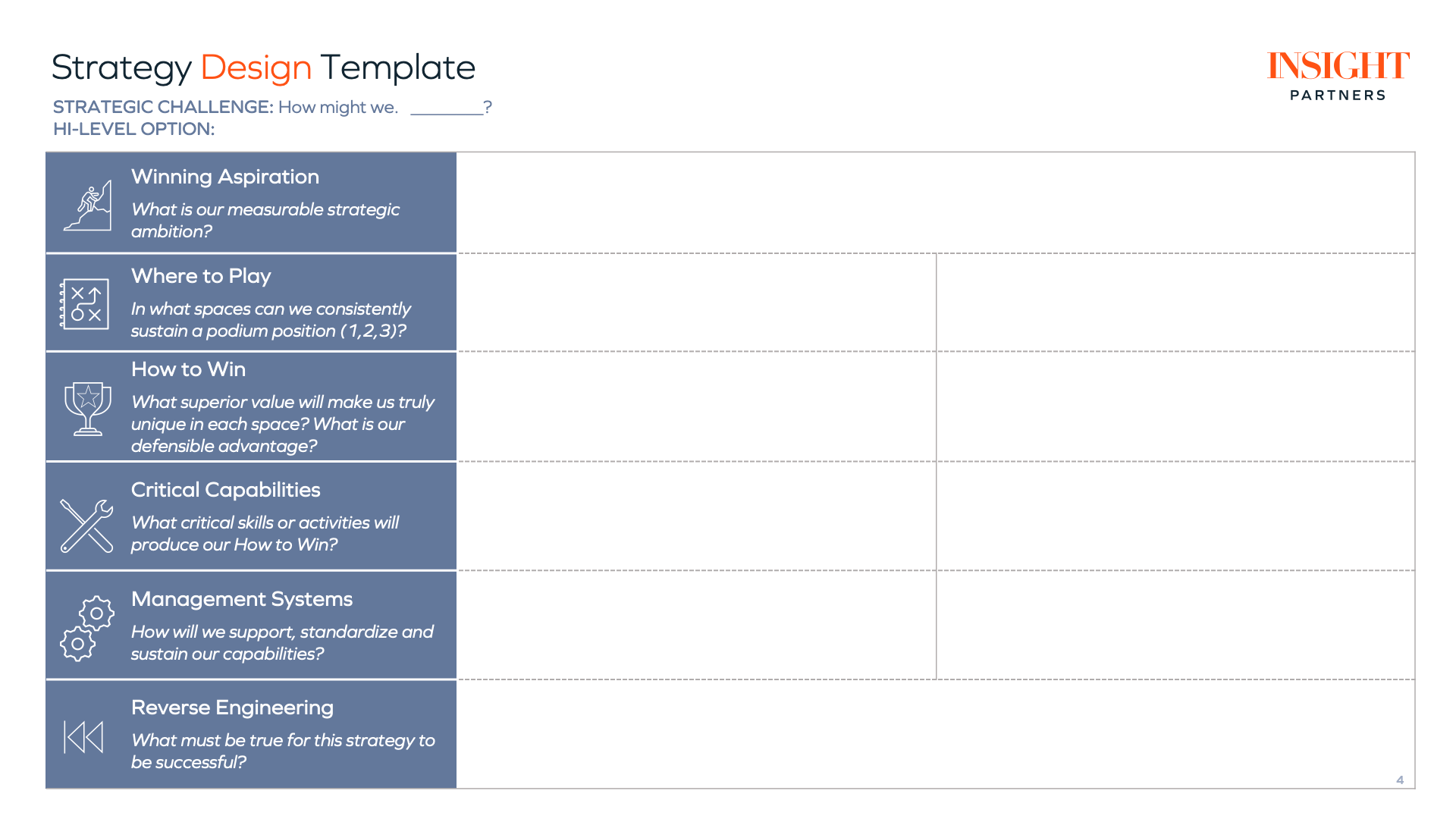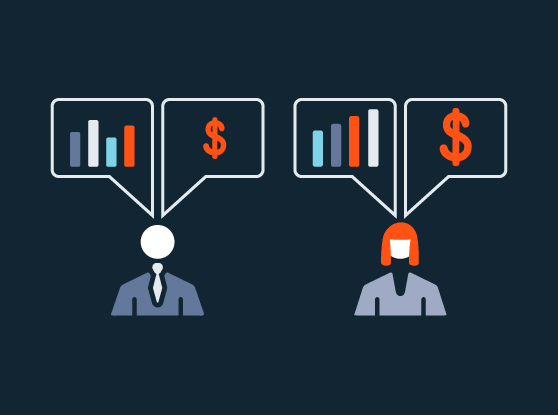The 1-Day Strategy Sprint: Framework, Process, and Tools

As ScaleUp operating strategists, we spend a good bit of time working with senior executives and functional leaders facilitating sessions focused on answering five deceptively simple questions:
- What is our winning aspiration?
- Where will we play?
- How will we win?
- What capabilities do we need?
- What management systems are required?
This is the now well-known choice-making framework known as “Playing to Win” presented in the 2013 book of the same name, co-authored by Roger Martin and famed former Procter & Gamble CEO A.G. Lafley.

Martin and Lafley define strategy as “a cascade of tightly integrated choices that uniquely positions a player in its market to create sustainable advantage and superior value relative to the competition.” Those choices must all fit together and reinforce each other in a logical way, making strategy design a bit of an art.
Strategy drives success
Over the past decade, the framework has taken root in many of the world’s most-winning businesses because it is a better, simpler, and far more effective way to think about strategy than conventional strategic planning. The authors argue that having a plan can certainly be complementary to strategy, but the real point of strategy is to increase the odds of success by making difficult tradeoffs and explicit statements about what you are choosing to do and not do—and why or why not—to optimize the use of available resources, which are always finite.
Make choices, not plans
Thinking about strategy as integrated choice-making rather than comprehensive plan-making is an important distinction, because irrespective of size or scale, a company that doesn’t decisively focus its resources on doing some things and not others simply will not succeed.
In practice, a choice-making session is a fluid and dynamic method of strategy formulation blending logic and creativity to produce an intelligent hypothesis about the future. The fact that strategy is focused on the future, which is uncertain and unknown, drives the need for immediate need to reverse-engineer the logic behind your choices to surface key assumptions and leaps of faith. If you don’t, it will most certainly be done for you by customers and competitors once you go to market!
Ask what must be true
The simple but powerful technique for reverse-engineering any set of choices is asking what Lafley/Martin maintain is the most important question in strategy: What must be true?
Asking this question about your choices allows you to tease out the preconditions for success. It’s important to note that the question is not concerned with what is true, or what could be true, but rather what would have to be true for the strategy to work as you envision it.
If a specific condition necessary for success may not be true, then it is a potential barrier to eventual success, and you must conduct a test to determine the validity and provide a higher level of confidence. Your new strategy is best thought of as a prototype, and like any prototype, it must be tested.
The perfect framework for scale
For a rapidly scaling, high-growth, time-crunched company, the advantages of developing a strategy using the Playing to Win (P2W) framework are several.
First, it makes the entire strategy design process significantly faster and lighter; multiple strategy prototypes ready for testing can be formulated in one day with multi-team strategy sprints (assuming in-person workshops), versus weeks or even months under the conventional model. Second, you can point the P2W framework at any strategic challenge you wish, even those faced by internal, non-revenue-generating functions. Strategy is not reserved for the C-Suite only! Finally, once a strategy has been designed and deployed throughout the company, it boosts operating speed significantly by providing a clear and powerful context for decision-making.
Let’s explore how the development process works using the method we employ in our strategy design workshops with our portfolio companies. There are three basic steps: choose, reverse-engineer, test.
Step 1: Choose
Strategic challenge (30 mins)
The only reason to craft a new strategy is if the current one isn’t sufficient to get you from where you are to where you want to be, and resources must be redeployed. (NOT because it’s planning season!)
Identify the strategic issue in question form, using the “How Might We” wording. This is the preferred language by designers, and you are designing a new strategy. “How can we” implies a current capability, and “how should we” implies a judgment, both of which limit thinking.
This is a short “framestorming” segment focused on properly framing—and gaining consensus on—the strategic problem you’re facing.
Examples:
- How might we move upmarket from SMB to mid-market?
- How might we improve our innovation ROI?
Reframe the challenge (30 mins)
This is where the P2W process departs from tradition: Instead of immediately trying to solve the problem with the best solution, identify at least two different high-level options or alternatives that could solve the issue. There is always more than one way to “skin the strategy cat,” so to speak. That’s why you have competitors in the first place! Different options will require different choices, which is exactly what you want to explore.
Examples:
- Option 1—Enter a new geography.
- Option 2—Develop new product.
Winning aspiration (30 mins)
Who are we winning with and for (customers)? Who are we winning against (competitors)?
The sine qua non of strategy is having a winning aspiration. There’s no safe spot in business, but the safest is at or very near the top. If you are not in podium position, or constantly angling to get there, not only will you not focus your resources effectively, but the current market leaders will use the assets that accrue to winners to ensure you never will.
Define your measurable strategic ambition, so that you will be able to determine when you are winning. Don’t be modest; don’t play to play, or play to not lose.
Examples:
- First to market with a cloud infrastructure-as-a-service solution for internal developers. (AWS)
- Recognized leader in smart wireless audio systems for the connected home. (SONOS)
- Premier advanced machine learning credit underwriting model for financial institutions, (Zest.ai)
Where to play + how to win (90 mins)
In what spaces or segments can we consistently sustain a podium position (1,2,3)?
What differentiated and defensible value will make us the superior player in each space?
These two questions form the heart of your strategy. Both choices must be taken together, as they are inseparable. Choosing a space without a defensible value equation for how you’ll dominate it and differentiate your offerings is useless.
Consider all relevant resource focal points: geographies, segments, customers, channels, categories, stages of production, etc. Be explicit about where NOT to play or stop playing.
When it comes to your How to Win, be very specific about value elements (quality, cost, speed, experience, etc.). Avoid generic statements that are false choice such as “superior customer experience” or “operational excellence.” If you can’t imagine a competitor choosing a completely different or even opposite way to win in your chosen spaces, you have not made a choice. In other words, unless you can imagine winning with “inferior customer experience” or “operational dysfunction” in the examples here, superior customer experience and operational excellence are not choices; they are simply ante to the game.
Capabilities needed (45 mins)
What key skills and activities will produce our How to Win?
Capabilities are the critical current and future skills and core activities that must be in place and performed at the highest level to achieve the advantage in each space.
Do not simply list your competencies. Just because you are good at something doesn’t necessarily mean it gives rise to your superior value equation. For example, Southwest Airlines would not list “pilot quality” as a capability, because their pilots don’t need to be better than any other airline’s.
Finally, do not limit your choices to the capabilities you currently have. Focus on what must be in place for your strategy to work, irrespective of whether you have those capabilities today. Capabilities can be bought, developed, borrowed, partnered, etc. The important characteristic that gives capability is critical to producing your How to Win.
Examples:
- Deep customer understanding
- Go-to-market ability
- New product innovation
Management Systems (45 mins)
How will we support and sustain your critical capabilities?
Management systems include key processes, structures, standards, rules, reviews, metrics, and dashboards that reinforce your critical capabilities and support your strategic choices. To be considered as a required management system, you should be able to draw a straight line to one or more of the capabilities you’ve listed as needed for your How to Win. The goal is to ensure that your capabilities remain at their highest level and find a way to communicate them.
Examples:
- Customer advisory board
- Sales operations reviews
- Innovation governance
Step 2: Reverse-engineer
What must be true? (45 mins)
- What must be true about the openness, structure, and dynamics of your spaces?
- What must be true about what your company, channels, and customers truly value?
- What must be true about your critical capabilities and relative costs?
- What must be true about how your competitors might react to your strategy?
Once you’ve listed a few pre-conditions for success, discuss whether any of your what-must-be-trues rise to the level of “worrisome,” meaning you’re not certain whether a given condition is in fact true, represents a risk, or has great potential impact on the success of your strategy. You may have a few that you consider leaps of faith that must be tested before thinking about deployment.
The goal here is to avoid experiencing the Mike Tyson quote: “Everyone has a plan until they get punched in the mouth.”
Select your most worrisome what-must-be-true for the final step: test design.
Step 3: Test
Design an experiment (45 mins)
- What condition concerns you most?
- What do you need to confirm?
- What test would give you confidence?
- What will be your measure of success?
This is basic hypothesis testing, and once you’ve constructed it, you’ve completed the strategy-design process.
Note that the Playing to Win strategy-design process essentially flips the conventional analyze-plan-execute method on its head with a choose-reverse-engineer model more relevant for rapidly changing market conditions representative of our current business climate.
The Playing-to-Win strategy canvas
In our strategy-design sessions, we often have multiple teams working simultaneously on the same strategic challenge, each taking a different high-level option. Our process utilizes a proprietary tool, a large wall canvas that not only helps guide strategic thinking but also provides a tangible artifact of the team’s work product. Basic visual canvas rule applies: Post-It notes and sharpies are the preferred utensils.

A printable version of this template can be found here: Playing to Win Canvas PDF.
To use the canvas with a remote collaboration tool, simply drop the PDF onto your whiteboard, resize it to your preference, then lock it so that it does not move.
When you finally land on a preferred strategy, you should be able to easily compose it on a single page, such as the one shown below.

Content adapted from What a Unicorn Knows: How Leading Entrepreneurs Use Lean Principles to Drive Sustainable Growth, by Matthew E. May and Pablo Dominguez.









